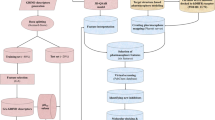Abstract
Pteridine reductase is a promising target for development of novel therapeutic agents against Trypanosomatid parasites. A 3D-QSAR pharmacophore hypothesis has been generated for a series of L. major pteridine reductase inhibitors using Catalyst/HypoGen algorithm for identification of the chemical features that are responsible for the inhibitory activity. Four pharmacophore features, namely: two H-bond donors (D), one Hydrophobic aromatic (H) and one Ring aromatic (R) have been identified as key features involved in inhibitor-PTR1 interaction. These features are able to predict the activity of external test set of pteridine reductase inhibitors with a correlation coefficient (r) of 0.80. Based on the analysis of the best hypotheses, some potent Pteridine reductase inhibitors were screened out and predicted with anti-PTR1 activity. It turned out that the newly identified inhibitory molecules are at least 300 fold more potent than the current crop of existing inhibitors. Overall the current SAR study is an effort for elucidating quantitative structure-activity relationship for the PTR1 inhibitors. The results from the combined 3D-QSAR modeling and molecular docking approach have led to the prediction of new potent inhibitory scaffolds.






Similar content being viewed by others
References
Bello AR, Nare B, Freedman D, Hardy L, Beverley SM (1994) PTR1: a reductase mediating salvage of oxidized pteridines and methotrexate resistance in the protozoan parasite Leishmania major. Proc Natl Acad Sci USA 91:11442–11446
Nare B, Hardy LW, Beverley SM (1997) The roles of pteridine reductase 1 and dihydrofolate reductase-thymidylate synthase in pteridine metabolism in the protozoan parasite Leishmania major. J Bio Chem 272:13883–13891
Nare B, Luba J, Hardy LW, Beverley S (1997) New approaches to Leishmania chemotherapy: pteridine reductase 1 (PTR1) as a target and modulator of antifolate sensitivity. Parasitology 114(Suppl):S101–110
Soto J, Arana BA, Toledo J, Rizzo N, Vega JC, Diaz A, Luz M, Gutierrez P, Arboleda M, Berman JD, Junge K, Engel J, Sindermann H (2004) Miltefosine for new world cutaneous leishmaniasis. Clin Infect Dis 38:1266–1272
Arevalo J, Ramirez L, Adaui V, Zimic M, Tulliano G, Miranda-Verastegui C, Lazo M, Loayza-Muro R, De Doncker S, Maurer A, Chappuis F, Dujardin JC, Llanos-Cuentas A (2007) Influence of Leishmania (Viannia) species on the response to antimonial treatment in patients with American tegumentary leishmaniasis. J Infect Disease 195:1846–1851
Badaro R, Lobo I, Munos A, Netto EM, Modabber F, Campos-Neto A, Coler RN, Reed SG (2006) Immunotherapy for drug-refractory mucosal leishmaniasis. J Infect Disease 194:1151–1159
Sundar S, Chakravarty J, Agarwal D, Rai M, Murray HW (2010) Single-dose liposomal amphotericin B for visceral leishmaniasis in India. N Engl J Med 362:504–512
Sundar S, Jha TK, Thakur CP, Sinha PK, Bhattacharya SK (2007) Injectable paromomycin for Visceral leishmaniasis in India. N Engl J Med 356:2571–2581
Gourley DG, Schuttelkopf AW, Leonard GA, Luba J, Hardy LW, Beverley SM, Hunter WN (2001) Pteridine reductase mechanism correlates pterin metabolism with drug resistance in trypanosomatid parasites. Nat Struct Biol 8:521–525
Sienkiewicz N, Ong HB, Fairlamb AH (2010) Trypanosoma brucei pteridine reductase 1 is essential for survival in vitro and for virulence in mice. Mol Microbiol 77:658–671
Tulloch LB, Martini VP, Iulek J, Huggan JK, Lee JH, Gibson CL, Smith TK, Suckling CJ, Hunter WN (2010) Structure-based design of pteridine reductase inhibitors targeting African sleeping sickness and the leishmaniases. J Med Chem 53:221–229
Cavazzuti A, Paglietti G, Hunter WN, Gamarro F, Piras S, Loriga M, Allecca S, Corona P, McLuskey K, Tulloch L, Gibellini F, Ferrari S, Costi MP (2008) Discovery of potent pteridine reductase inhibitors to guide antiparasite drug development. Proc Natl Acad Sci USA 105:1448–1453
Schüttelkopf AW, Hardy LW, Beverley SM, Hunter WN (2005) Structures of Leishmania major pteridine reductase complexes reveal the active site features important for ligand binding and to guide inhibitor design. J Mol Biol 352:105–116
McLuskey K, Gibellini F, Carvalho P, Avery MA, Hunter WN (2004) Inhibition of Leishmania major pteridine reductase by 2,4,6-triaminoquinazoline: structure of the NADPH ternary complex. Acta Crystallogr D Biol Crystallogr 60:1780–1785
Shanks EJ, Ong HB, Robinson DA, Thompson S, Sienkiewicz N, Fairlamb AH, Frearson JA (2010) Development and validation of a cytochrome c-coupled assay for pteridine reductase 1 and dihydrofolate reductase. Anal Biochem 396:194–203
Ferrari S, Morandi F, Motiejunas D, Nerini E, Henrich S, Luciani R, Venturelli A, Lazzari S, Calò S, Gupta S, Hannaert V, Michels PA, Wade RC, Costi MP (2010) ScreeningiIdentification of nonfolate compounds, including a CNS drug, as antiparasitic agents inhibiting pteridine reductase. J Med Chem 54:211–221
Mpamhanga CP, Spinks D, Tulloch LB, Shanks EJ, Robinson DA, Collie IT, Fairlamb AH, Wyatt PG, Frearson JA, Hunter WN, Gilbert IH, Brenk R (2009) One scaffold, three binding modes: novel and selective pteridine reductase 1 inhibitors derived from fragment hits discovered by virtual screening. J Med Chem 52:4454–4465
Spinks D, Ong HB, Mpamhanga CP, Shanks EJ, Robinson DA, Collie IT, Read KD, Frearson JA, Wyatt PG, Brenk R, Fairlamb AH, Gilbert IH (2011) Design, synthesis and biological evaluation of novel inhibitors of Trypanosoma brucei pteridine reductase 1. Chem Med Chem 6:302–308
Chen JJ, Liu TL, Yang LJ, Li LL, Wei YQ, Yang SY (2009) Pharmacophore modeling and virtual screening studies of checkpoint kinase 1 inhibitors. Chem Pharm Bull 57:704–709
Thangapandian S, Krishnamoorthy NK, John S, Sakkiah S, Lazar P, Lee Y, Lee KW (2010) Pharmacophore modeling, virtual screening and molecular docking studies for identification of new inverse agonists of human histamine H 1 receptor. Bull Korean Chem Soc 31:52–58
Irwin JJ, Shoichet BK (2005) ZINC–a free database of commercially available compounds for virtual screening. J Chem Inf Model 45:177–182
Venkatachalam CM, Jiang X, Oldfield T, Waldman M (2003) LigandFit: a novel method for the shape-directed rapid docking of ligands to protein active sites. J Mol Graph Model 21:289–307
Kumar M, Verma S, Sharma S, Srinivasan A, Singh TP, Kaur P (2010) Structure-based in silico design of a high-affinity dipeptide inhibitor for novel protein drug target Shikimate kinase of Mycobacterium tuberculosis. Chem Biol Drug Des 76:277–284
Güner OF (2000) Pharmacophore perception, development, and use in drug design. International University Line, La Jolla, CA
Acknowledgments
Authors acknowledge Indian Council of Medical Research, India for grant of Bio-Medical Informatics Centre. DD thanks Department of Science & Technology, India for financial support.
Author information
Authors and Affiliations
Corresponding author
Rights and permissions
About this article
Cite this article
Dube, D., Periwal, V., Kumar, M. et al. 3D-QSAR based pharmacophore modeling and virtual screening for identification of novel pteridine reductase inhibitors. J Mol Model 18, 1701–1711 (2012). https://doi.org/10.1007/s00894-011-1187-0
Received:
Accepted:
Published:
Issue Date:
DOI: https://doi.org/10.1007/s00894-011-1187-0




